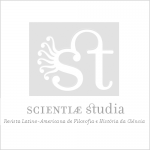Estruturas conceituais e estratégias de investigação: modelos representacionais e instanciais, analogias e correspondência
Vol. 9, No. 3 • Scientiae Studia
Autor: Valter Alnis Bezerra
Resumo:
São discutidas, neste artigo, determinadas estratégias de investigação científica que têm em comum as características de estar fundadas sobre as noções de modelo e de depender de um contraponto entre duas ou mais estruturas. São focalizadas três dessas estratégias científicas. Analisa-se, primeiramente, a modelagem, tal como entendida usualmente na ciência. Para isso, distinguem-se duas noções de modelo: a noção lógica ou instancial e a noção prototeórica ou representacional. Ao mesmo tempo em que são assinaladas as diferenças entre as duas acepções do termo, procura-se também compreender de que maneira elas estão relacionadas. Em particular, para investigar a relação (entre estruturas e realidade) de modelagem representacional é preciso invocar a relação (entre estruturas e estruturas) de modelagem lógica. A análise dos modelos também contribui para elucidar a relação de adequação empírica entre as teorias científicas e os dados, por meio da noção de subestrutura empírica ou modelo de dados. São consideradas, em segundo lugar, as analogias. O seu funcionamento é aqui analisado em termos de modelos e isomorfismos parciais, o que permite capturar a ideia de uma tradução dos problemas e de suas soluções em domínios de investigação diferentes. Destaca-se o papel importante desempenhado pelas analogias no pensamento científico de Maxwell (que também atribuía lugar de destaque aos modelos). Em terceiro lugar, discute-se o princípio de correspondência, que historicamente desempenhou um papel notável na primeira fase da teoria quântica. São identificadas duas formas, de teor diferente, que o princípio assumiu na teoria quântica, sendo ambas elucidadas em termos de modelos. Para contextualizar a discussão sobre o princípio de correspondência, e também para exemplificar as características dos modelos representacionais, dedica-se aqui uma atenção especial ao modelo atômico de Bohr-Sommerfeld.
Abstract:
In the present article some strategies of scientific inquiry are discussed which have a pair of features in common: first, they are based on the notions of model, and second, they depend on a counterpoint between two or more structures. Three strategies of this kind are considered. First, I consider modeling in the usual scientific sense. In order to do this, one distinguishes between two notions of model: the logical or instantial one, and the proto-theoretical or representational one. While the differences between both senses of the term are highlighted, an attempt is also made to understand the sense in which the two are related to one another. In particular, in order to investigate the structure-reality relationship of representational modeling, one needs to invoke the structure-structure relationship of logical modeling. The analysis of models contributes also to clarify the relational nature of empirical adequacy between scientific theories and data, through the notion of empirical substructure or model of data. Second, analogies are considered. Their operation is analyzed here in terms of models and partial isomorphisms, which allows one to grasp the idea of a translation of problems (and their solutions) across distinct domains of inquiry. The important role played by analogies in the thought of Maxwell (who also notably valued models) is highlighted. Third, I discuss the principle of correspondence, which historically played a remarkable role in the first period of quantum theory. The principle acquired two distinct forms, different in meaning, both of which can be clarified through the use of models. The Bohr-Sommerfeld model of the atom receives special attention, both in order to provide a context for discussing the principle of correspondence, and to exemplify the features of representational models as well.
DOI: http://dx.doi.org/10.1590/S1678-31662011000300007
Texto Completo: http://www.scielo.br/scielo.php?script=sci_arttext&pid=S1678-31662011000300007&lng=pt&nrm=iso&tlng=pt
Palavras-Chave: Modelo,Analogia,Estrutura,Prototeoria, Modelo

Scientiae Studia
Associação Filosófica Scientiae Studia - Revista Scientiae Studia
